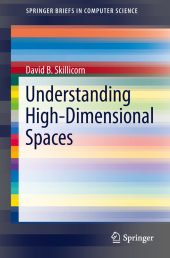 Neuerscheinungen 2012Stand: 2020-01-07 |
Schnellsuche
ISBN/Stichwort/Autor
|
Herderstraße 10
10625 Berlin
Tel.: 030 315 714 16
Fax 030 315 714 14
info@buchspektrum.de |

David B. Skillicorn
Understanding High-Dimensional Spaces
2012. 2012. ix, 108 S. 29 SW-Abb. 235 mm
Verlag/Jahr: SPRINGER, BERLIN 2012
ISBN: 3-642-33397-4 (3642333974)
Neue ISBN: 978-3-642-33397-2 (9783642333972)
Preis und Lieferzeit: Bitte klicken
This book proposes new ways of thinking about high-dimensional spaces using two models: the skeleton that relates the clusters to one another, and the boundaries in empty space that provide new perspectives on outliers and on outlying regions.
High-dimensional spaces arise as a way of modelling datasets with many attributes. Such a dataset can be directly represented in a space spanned by its attributes, with each record represented as a point in the space with its position depending on its attribute values. Such spaces are not easy to work with because of their high dimensionality: our intuition about space is not reliable, and measures such as distance do not provide as clear information as we might expect.
There are three main areas where complex high dimensionality and large datasets arise naturally: data collected by online retailers, preference sites, and social media sites, and customer relationship databases, where there are large but sparse records available for each individual; data derived from text and speech, where the attributes are words and so the corresponding datasets are wide, and sparse; and data collected for security, defense, law enforcement, and intelligence purposes, where the datasets are large and wide. Such datasets are usually understood either by finding the set of clusters they contain or by looking for the outliers, but these strategies conceal subtleties that are often ignored. In this book the author suggests new ways of thinking about high-dimensional spaces using two models: a skeleton that relates the clusters to one another; and boundaries in the empty space between clusters that provide new perspectives on outliers and on outlying regions.
The book will be of value to practitioners, graduate students and researchers.
Introduction.- Basic Structure of High-Dimensional Spaces.- Algorithms.- Spaces with a Single Center.- Spaces with Multiple Clusters.- Representation by Graphs.- Using Models of High-Dimensional Spaces.- Including Contextual Information.- Conclusions.- Index.- References.
From the reviews:
Selected by Computing Reviews as one of the Best Reviews & Notable Books of 2013
"This brief eight-chapter book seeks to provide the reader with the tools to perform analysis of high-dimensional datasets and spaces. ... book follows a very gentle trajectory. ... This gentle approach makes the book accessible to those unfamiliar with the field of data analysis. ... a good introduction to the area of cluster analysis of high-dimensional data. ... a useful addition to the existing literature on cluster analysis in high-dimensional spaces by providing a starting point for those wanting an initial grounding in the area." (Harry Strange, Computing Reviews, May, 2013)


